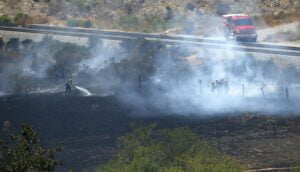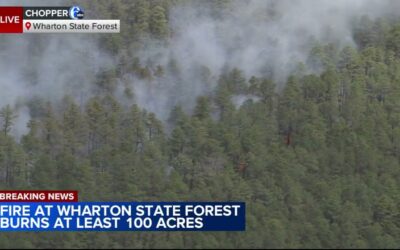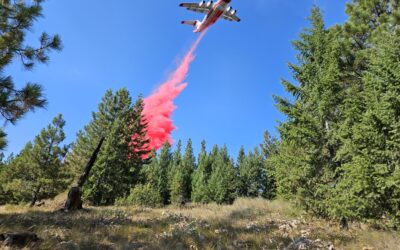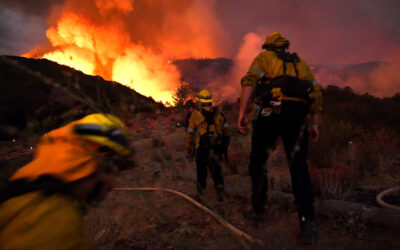
A one-acre brush fire broke out along the railroad tracks in Rose Canyon in University City on August 15, 2019. The train tracks were shut down briefly while crews got the blaze under control.
David Garrick – The San Diego Union-Tribune
A new audit says San Diego should boost its wildfire prevention efforts by more closely monitoring 3,000 acres of city land in high-risk areas and revamping inconsistent policies governing the removal of flammable brush.
The 35-page audit says proactive efforts are especially crucial with climate change and extreme drought raising local wildfire risk. It comes as San Diego enters the region’s peak fire season, which runs from July through October.
The report says San Diego lacks comprehensive oversight of brush management, which results in inconsistent and potentially ineffective efforts by some of the 10 city departments that oversee land with high fire risk.
The audit criticizes the city’s Fire-Rescue Department for not proactively monitoring and inspecting city-owned land in high-risk areas, practicesit says are common for fire departments in other cities.
It recommends a citywide brush management policy that would ensure consistent efforts and compliance, primarily by unifying the approaches taken by various city departments.
The city’s Parks and Recreation Department — which controls 2,039 of the high-risk acres — is praised in the audit for having a comprehensive approach that includes “regular and effective” brush management.
In contrast, the city’s Transportation and Public Utilities departments are criticized for brush management policies that are “primarily reactive” and “generally less systematic.” Public Utilities controls 649 acres and Transportation 206.
Auditors used 3,203 as the number of acres needing close wildfire monitoring based on the city’s general definition of high wildfire risk zones. But they note that the actual number is somewhat lower than that.
That is because although the city’s municipal code eliminates 100-foot defensible space requirements for structures built after 1989 or for land where the fire chief has approved alternative compliance, there is no easy way to calculate how many of the 3,203 acres this eliminates.
The audit makes seven recommendations that city officials have agreed to implement during the ongoing fiscal year or during fiscal year 2025, which begins next July.
One recommendation will require city fire officials to identify all city-owned lands that need brush management, proactively monitor them and keep records on brush management efforts there.
The audit also asks Eric Dargan, the city’s chief operating officer, to consolidate brush management responsibilities so that departments aren’t handling wildfire mitigation separately. More collaboration among departments is also recommended.
The Parks and Recreation Department is urged in the audit to come up with brush management strategies for “paper” streets — city streets that appear on maps but that have not yet been built.
The department is also asked to evaluate the contractors it has used for brush management, gather feedback on them and share it with other city departments to help them hire quality contractors.
Lastly, the audit recommends Fire-Rescue partner with Parks and Rec to determine how much more money the city would need to effectively carry out its overall brush management responsibilities.
In response, Dargan praised the recommendations and noted that some related progress was made before the audit.
Departments engaged in brush management efforts have been meeting to discuss best practices, he said. The Fire-Rescue Department has been pursuing grant opportunities and working with other city departments to create and refine maps of high-risk areas. Fire-Rescue has also asked for new employees who would be classified as wildfire mitigation specialists.
This story originally appeared in San Diego Union-Tribune.
©2023 The San Diego Union-Tribune. Visit sandiegouniontribune.com. Distributed by Tribune Content Agency, LLC.




